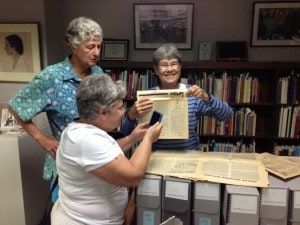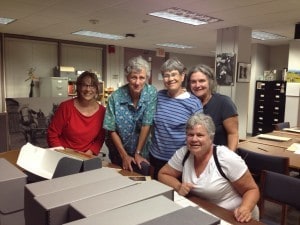This post was written by Jessica Lawson, Graduate Research Assistant in the Iowa Women’s Archives.
The Iowa Women’s Archives had an exciting visit at the end of July! Five founding members of Iowa City’s Emma Goldman Clinic—Dale McCormick, Sondra Smith, Gayle Sand, Barb Yates, and Francie Hornstein—reunited to look through this feminist health clinic’s records and share memories of its early days. The Emma Goldman Clinic (fondly known as “Emma”) is a not-for-profit healthcare and family planning provider whose records are housed at the Archives.

Barb Yates, Francie Hornstein, and Dale McCormick looking at Ain’t I a Woman, published by the Women’s Liberation Front in Iowa City in the early 1970s.
The collections we brought out for the founders’ visit, as well as the stories they shared, reflect the rich interconnections among women’s organizations and social justice movements in Iowa City in the 1970s. In addition to the material in the Emma Goldman Clinic Records themselves, the history of the clinic is woven through the personal papers of two of the visitors (Dale McCormick and Sondra Smith), as well as other local activists like Jill Jack and Linda Yanney and organizations such as the Women’s Resource and Action Center (WRAC). The women laughed as they told stories about staging a feminist revision of Taming of the Shrew, proudly compared their work on Ain’t I a Woman (the newsletter of the Iowa City Women’s Liberation Front) to the work of women’s groups in New York City in the 1970s, and paused to celebrate the memory of Iowa Women’s Archives co-founder Louise Noun. They even found time to help us identify some of the faces in the old photographs.
